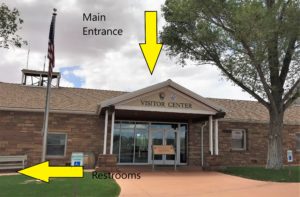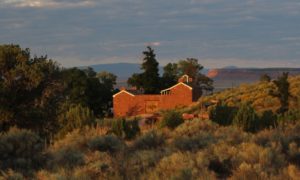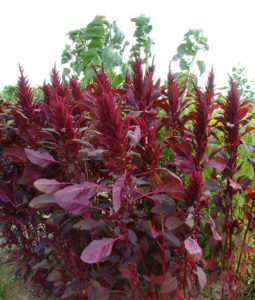Tom and I finished working at Pipe Spring on September 29. Although I still have a few more posts about things we saw on our days off, this will be the last post about working at Pipe Spring (I think). So I will do my usual “Frequently Asked Questions” post. You can read the previous FAQ posts here: Death Valley, Chickamauga and Chattanooga, Kings Mountain, Fort Frederica, Grand Portage, and San Juan.
 The most frequent question here at Pipe Spring brings us back to the purpose of Visitors Centers. As they come in, or before they leave, most people ask us “where is the restroom?” Our restrooms are located in a separate part of the building, so we usually answer “outside and to the right.” Sometimes we add “second door on the right.” Gail is our cleaning custodian and she does a great job keeping the restrooms clean. We never have people tell us that we are out of toilet paper or paper towels.
The most frequent question here at Pipe Spring brings us back to the purpose of Visitors Centers. As they come in, or before they leave, most people ask us “where is the restroom?” Our restrooms are located in a separate part of the building, so we usually answer “outside and to the right.” Sometimes we add “second door on the right.” Gail is our cleaning custodian and she does a great job keeping the restrooms clean. We never have people tell us that we are out of toilet paper or paper towels.
 A question we get almost as frequently as the restroom question is “what are you?” This question isn’t as strange as it sounds in the context of the Visitors Center. Most of our visitors (90%) are doing the Grand Circle. They are are either on their way to the North Rim of the Grand Canyon or to Zion. Many of them were not planning on stopping at Pipe Spring, but they see our sign and say “Oh, another National Park!” When they come, they don’t know anything about us and wonder if we are worth the time and money.
A question we get almost as frequently as the restroom question is “what are you?” This question isn’t as strange as it sounds in the context of the Visitors Center. Most of our visitors (90%) are doing the Grand Circle. They are are either on their way to the North Rim of the Grand Canyon or to Zion. Many of them were not planning on stopping at Pipe Spring, but they see our sign and say “Oh, another National Park!” When they come, they don’t know anything about us and wonder if we are worth the time and money.
We usually answer the question “what is this place?” by talking about the water. “We tell the story of water. We have a spring that is a good source of year-round water here in the desert. The Kaibab Paiute had used the spring for over 900 years. In 1870 the Latter Day Saints pioneers came here and built a fort over the spring. This caused some problems and we talk about how those problems were solved – or are still disputed.” That is the park in a nutshell and usually lets people know whether they want to enter the monument.
 A third frequently asked question is “What is that purple plant in the garden?” We have a large garden and it has some unusual plants. The large purple plant is amaranth which grows wild here or can be cultivated. Amaranth has tiny, edible, starchy seeds that were harvested by the Paiute when they lived as hunter-gatherers. The grain can be popped, like a little popcorn, or eaten as a grain like cereal or mixed with fruit. The amaranth is ripe now, so I shake off some of the seeds into my hand, blow the chaff away, and show them the seeds.
A third frequently asked question is “What is that purple plant in the garden?” We have a large garden and it has some unusual plants. The large purple plant is amaranth which grows wild here or can be cultivated. Amaranth has tiny, edible, starchy seeds that were harvested by the Paiute when they lived as hunter-gatherers. The grain can be popped, like a little popcorn, or eaten as a grain like cereal or mixed with fruit. The amaranth is ripe now, so I shake off some of the seeds into my hand, blow the chaff away, and show them the seeds.
The strangest question I’ve gotten at Pipe is one that happened the other day while I was spinning. I was sitting in my cool, shady spot by the pools, spinning wool on the wheel. A couple walked up toward me. I looked up, smiled, and said “Hello!” The husband jumped up in the air and yelled, “Oh, are you real?” His wife and I laughed about it. He thought I was some kind of mannequin. I mentioned that he saw the wheel spinning, but he thought there must be some kind of motor on it. After determining I was a real person, they came over to me and we had a nice talk about spinning.
I never know what kind of questions I get when I work. The variety of questions keeps the job interesting.

2 comments